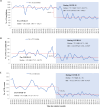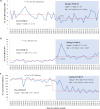Assessing the impact of COVID-19 on HIV care cascade for people living with HIV in Ethiopia: a retrospective longitudinal study
- PMID: 39486827
- PMCID: PMC11529552
- DOI: 10.1136/bmjopen-2024-084244
Assessing the impact of COVID-19 on HIV care cascade for people living with HIV in Ethiopia: a retrospective longitudinal study
Abstract
Objective: The study aimed to investigate the impact of COVID-19 on the cascade of HIV care for people living with HIV (PLHIV) in Ethiopia.
Design: A retrospective longitudinal study.
Setting: The study was conducted in North Showa Zone, Ethiopia, from pre-COVID-19 (January 2018-December 2019) and during COVID-19 (January 2020-December 2021).
Participants: We identified 61901 records from 3925 PLHIV, of which 23 848 were recorded during the pandemic.
Main outcome measure: We investigated indicators from four stages of the HIV care cascade, including HIV screening and diagnosis, HIV care, HIV treatment and HIV disease progression, according to a WHO framework. The indicator changes were assessed with incidence rate ratios (IRRs).
Results: For HIV screening and diagnosis, the monthly number of HIV tests experienced a 46% decline from 2520 to 1361 since the pandemic (IRR 0.553; 95% CI 0.546 to 0.561). For HIV care, the monthly number of consultations was reduced by 49.6% (from 1582 to 798) since the pandemic (IRR 0.591; 95% CI 0.581 to 0.601). Similarly, the monthly number of viral load tests was reduced by 42.8% (IRR 0.614; 95% CI 0.581 to 0.650). For HIV treatment, the number of antiretroviral therapy (ART) initiations was reduced by 27.8% and the number of ART adherence by 52.5% since the pandemic. For HIV disease progression, the monthly number of PLHIV achieving viral suppression was reduced by 61.6%, while HIV-related deaths doubled during the pandemic.
Conclusion: The study highlights pandemic-induced disruptions in the cascade of care for PLHIV. Targeted interventions are necessary to protect PLHIV in public health emergencies.
Keywords: COVID-19; HIV & AIDS; Health Services.
© Author(s) (or their employer(s)) 2024. Re-use permitted under CC BY. Published by BMJ.
Conflict of interest statement
Competing interests: None declared.
Figures






Similar articles
-
Tuberculosis preventive treatment uptake among people living with HIV during COVID-19 period in Addis Ababa, Ethiopia: a retrospective data review.BMC Infect Dis. 2024 May 17;24(1):499. doi: 10.1186/s12879-024-09403-z. BMC Infect Dis. 2024. PMID: 38760665 Free PMC article.
-
The Impact of COVID-19 on the HIV Cascade of Care in Botswana - An Interrupted Time Series.AIDS Behav. 2024 Aug;28(8):2630-2638. doi: 10.1007/s10461-024-04388-x. Epub 2024 Jun 10. AIDS Behav. 2024. PMID: 38856847 Free PMC article.
-
Risk indicators for oral ulcers among people living with HIV during the first wave of the pandemic: a cross sectional study.BMC Oral Health. 2023 Aug 27;23(1):600. doi: 10.1186/s12903-023-03330-2. BMC Oral Health. 2023. PMID: 37635219 Free PMC article.
-
Incidence and predictors of opportunistic infections in adolescents and adults after the initiation of antiretroviral therapy: A 10-year retrospective cohort study in Ethiopia.Front Public Health. 2022 Dec 15;10:1064859. doi: 10.3389/fpubh.2022.1064859. eCollection 2022. Front Public Health. 2022. PMID: 36589962 Free PMC article. Review.
-
The latent tuberculosis cascade-of-care among people living with HIV: A systematic review and meta-analysis.PLoS Med. 2021 Sep 7;18(9):e1003703. doi: 10.1371/journal.pmed.1003703. eCollection 2021 Sep. PLoS Med. 2021. PMID: 34492003 Free PMC article.
Cited by
-
The burden of HIV/AIDS in Ethiopia: Unveiling 30 years of trends in incidence, mortality, and disability-insights from the Global Burden of Disease study (1990-2021).PLoS One. 2025 Apr 15;20(4):e0321024. doi: 10.1371/journal.pone.0321024. eCollection 2025. PLoS One. 2025. PMID: 40233050 Free PMC article.
References
-
- Open Forum Infect Dis; 2021. The impact of the covid-19 pandemic on clinical follow-up, monitoring and regimen discontinuation for people living with hiv in the US.
Publication types
MeSH terms
LinkOut - more resources
Full Text Sources
Medical
